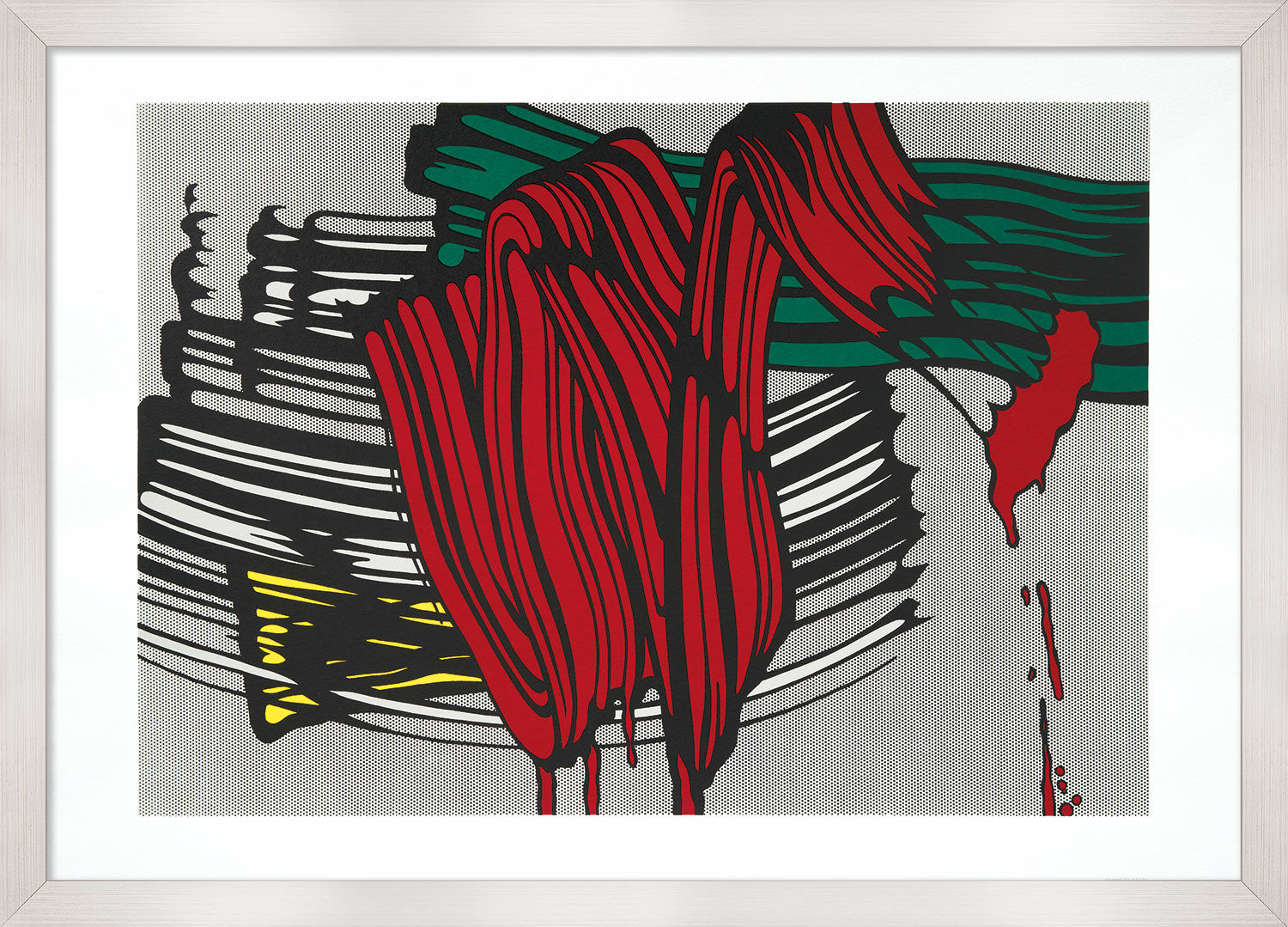Picture "Big Painting No. 6" (1965), framed


Picture "Big Painting No. 6" (1965), framed
Quick info
limited, 500 copies | screenprint on handmade paper | framed | glazed | size 77 x 107 cm (h/w)
Detailed description
Picture "Big Painting No. 6" (1965), framed
Original: Oil and magna on canvas, 233 x 328 cm, Collection Kunstsammlung Nordrhein-Westfalen.
High-quality screenprint edition on handmade paper. Limited edition of 500 copies. Motif size 59.5 x 84 cm (h/w). Sheet size 70 x 100 cm (h/w). Framed in silver-coloured solid wood frame, glazed. Size 77 x 107 cm (h/w). © VG Bild-Kunst, Bonn, 2000.

About Roy Lichtenstein
1923-1997
The American Roy Lichtenstein left his mark on Pop Art as only Andy Warhol did. His are exhibited in all the major art metropolises of the world.
His distinctive artistic feature is dots, which he applies in combination with areas of colour. A technique that had initially been developed for industrial printing in order to save ink and costs. Unlike Warhol, who prints his art, Lichtenstein paints these dots by hand. Perhaps the most famous representative of Pop Art was actually a classical painter.
Lichtenstein was born in New York on 27 October 1923. The son of a real estate broker, already knew that he wanted to become an artist at an early age. So, he began painting as a teenager. His role models were none other than Pablo Picasso, Claude Monet and Piet Mondrian.
Lichtenstein discovered the world of comics at the beginning of the 1960s after he had initially adopted the American Abstract Expressionism style. As a Pop artist, he emphasised the clichéd nature of a motif that, despite the suggestive titles, did not arouse any emotion in the viewer. In the mid- to late-1950s, Pop Art replaced the abstract art movement. It made use of kitschy or banal everyday culture images as a counter-reaction to the art of the previous decades, which rejected everything representational.
Lichtenstein studied at the Art Students League of New York and Ohio State University. He soon found his typical style: rough grids and cut-outs from the banal world of consumerism, comics and advertising. In his pictures, he was aiming to show the mechanisms of action in this world. The enlargement and simplification of familiar objects were intended to stimulate a new way of seeing.
But not only comics with love scenes, war scenes and science fiction stories were his inspiration, but also well-known works of art such as Claude Monet's "Rouen Cathedral", Pablo Picasso's portraits of women or Piet Mondrian's abstract paintings. His late work deals intensively with Japanese culture.
The painter and graphic artist, who died on 29 September 1997, also experimented with sculpture, using mainly brass, glass and marble.
The German magazine FOCUS celebrated him as the king of Pop Art on the occasion of a large exhibition in the Munich Kunsthalle. Roy Lichtenstein, the Pop artist from the very start, is one of the most sought-after artists in the world. His exhibitions – e.g. at the Guggenheim Museum in New York – are attracting record numbers of visitors.
Term for paintings and sculptures that are detached from the representational depiction, which spread throughout the entire western and parts of the eastern world from around 1910 onwards in ever new stylistic variations. The Russian painter Wassily Kandinsky, born in 1866, is considered the founder of abstract art. Other important artists of abstract art are K.S. Malewitsch, Piet Mondrian, and others.
The field of graphic arts, that includes artistic representations, which are reproduced by various printing techniques.
Printmaking techniques include woodcuts, copperplate engraving, etching, lithography, serigraphy.
In the early 1950s, a movement took over the cultural scene. Young artists from the US and the UK - completely independently of each other - severed their ties with all the traditions of artistic creativity and helped modernity to achieve a new art movement.
In the US there were Roy Lichtenstein, Andy Warhol, Tom Wesselmann and James Rosenquist who were seeking their themes in the world of advertising and comics, in star cult and anonymous urban culture. With flash colouring, over dimensioning and manipulating depth perspective they created new provocative works. thanks to the famous exhibition "This is Tomorrow" at London's Whitechapel Art Gallery, Richard Hamilton and Eduardo Paolozzi are to be considered as the true pioneers of Pop Art in England. In the 1960s, they were followed by David Hockney, Allan Jones, Peter Phillips and Derek Boshier.


